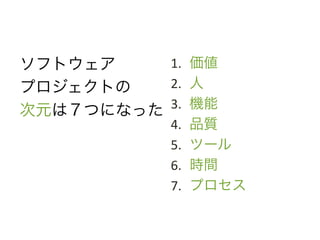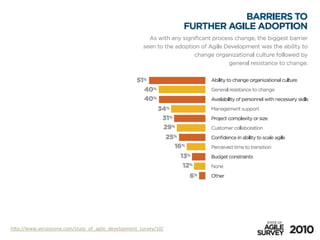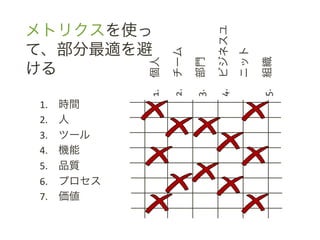Ad
アジャイルマネジメントとは?
- 1. アジャイル マネジメント? Jurgen Appelo version 2 Translated by @hardakiro
- 3. コンピュータ 1950 プログラミング 1960 1970 ソフトウェア エンジニアリング 1980 1990 アジャイル開発 2000 2010 秩序 複雑 カオス
- 4. プロジェクトの 伝統的な見方 スコープ 納期 費用
- 5. アジャイルの先駆者が 気がついたこと コスト(リソース)を人とツールに分ける スコープを機能と品質に分ける(sugges>on: ScoB Ambler) プロセスの次元を追加する(sugges>on: Alistair Cockburn) (ビジネス)価値の次元を追加する(sugges>on: Jim Highsmith) hBp://www.ambysoL.com/essays/brokenTriangle.html hBp://alistair.cockburn.us/index.php/Process:_the_fourth_dimension hBp://blog.cuBer.com/2009/08/10/beyond-‐scope-‐schedule-‐and-‐cost-‐measuring-‐agile-‐performance/
- 6. ソフトウェア 1. 価値 プロジェクトの 2. 人 次元は7つになった 3. 機能 4. 品質 5. ツール 6. 時間 7. プロセス
- 8. 価値 変化を抱擁する インクリメント 優先順位付け 価値マッピング フィードバック 頻繁に届ける バリューストリーム
- 9. 例: フィードバックか ら 価値を得るために ブログを書く
- 10. 人 多能工 同室 やりとり 尊敬 小さなチーム 協働 説明責任 信頼 自己組織化
- 12. 機能 市場性のある最小の機能 顧客を巻き込む ユーザーストーリー ユーザーデモ バックログ 受け入れ基準 “深さ1インチ、幅1マイル”
- 14. 品質 テスト駆動開発 技術的卓越 完了の定義 リファクタリング 出現する設計 ペアプログラミング シンプルさ
- 15. 例: チェックリストを 完了の定義として使う
- 16. ツール オープンオフィス タスクボード デイリービルド バージョン管理 継続的統合 テスト自動化 バーンチャート
- 18. 時間 段階的詳細化計画 タイムボックス 出荷可能な製品 リリース計画づくり イテレーション スプリント 持続可能なペース
- 20. プロセス スプリントプランニング スタンドアップミーティング コードの共同所有 ベロシティ ふりかえり プランニングポーカー スパイク
- 29. マネジメント 3.0 モデル 制約を コンピタンスを きれいに揃える 開発する チームに 権限委譲する 構造を 成長させる すべてを 人々を 改善する 活性化する
- 30. 視点 #1: 人々を活性化する 組織の中で最も重要な要素は人である。マ ネージャは、人々を活動的で、創造的で、 意欲あふれる状態にするためにできること は何でもやる。
- 32. 人々の本質的欲求を理解せよ
- 34. ギャラップの12の質問を使え 1. 仕事で自分に何を求められているか知っているか? 2. 正しく仕事を行うのに必要な材料、機材が利用できる状態か? 3. 職場では、毎日ベストを尽くせるか? 4. 過去7日の間に、自分のした良い仕事を認められたか?または褒められたか? 5. 会社の上司、同僚は、自分を個人として気遣ってくれるか? 6. 自分の成長を促してくれる人が職場にいるか? 7. 職場では、自分の意見が尊重してもらえるか? 8. 会社のミッション・目的によって、自分自身の仕事が大切だと思えるか? 9. 同僚は、良い仕事をすることにコミットしているか? 10. 職場に親友はいるか? 11. 過去6ヶ月間に、職場で自分の成長について話してくれた人がいるか? 12. 過去1年間に、職場で学び、成長する機会があったか?
- 35. 360 度 評価 ミーティングを組織せよ
- 36. 視点 #2: チームに権限委譲する チームは自己組織化できる。そのためには、 マネジメントからの権限委譲、承認、信頼 が必要である。
- 37. 庭師のようにマネージせよ
- 38. 重要な判断エリア を定義せよ “見えない電気柵” に人々が ひっかからないように
- 39. 権限の7つレベルを使う 1. 指示する: マネージャとして判断を下す 2. 売り込む: 判断について人々を説得する 3. 相談する: 判断する前にチームに意見を求める 4. 参加する: チームと一緒に判断する 5. 助言する: チームの判断に影響を与える 6. 確認する: チームが判断をした後にフィードバッ クを求める 7. 委譲する: 影響を与えない。チームが自分でやる
- 40. 権限ボードを作る
- 41. 視点 #3: 制約をきれいに揃える 自己組織化した結果は、どこに転ぶかわか らない。それゆえ、人々と共有リソースを 守り、明確な目的と、適切なゴールを示す 必要がある
- 42. コモンズの悲劇に対処する 制度 共有ルールを受け入れる信頼を作る 情報 状況の理解を深める 固有性 チーム間の帰属を深める 動機 個人の改善の必要性に対応する http://www.newscientist.com/article/mg20327225.700-‐triumph-‐of-‐the-‐commons-‐helping-‐the-‐world-‐to-‐share.html
- 45. 視点 #4: コンピタンスを開発する チームメンバーに能力が欠けていたら、 チームがゴールを達成できることはない。 そのため、マネージャは、コンピタンスの 開発に貢献しなければならない。
- 46. スキルと規律を区別せよ
- 47. コンピテンシーへの7つのアプローチを使え 1. 自己啓発 2. コーチング&メンタリング 3. トレーニング&認定 4. 文化&社会化 5. ツール&インフラ 6. 監督&統制 7. マネジメント
- 48. メトリクスを使っ 4. ビジネスユ て、部分最適を避 2. チーム ニット 1. 個人 3. 部門 5. 組織 ける 1. 時間 2. 人 3. ツール 4. 機能 5. 品質 6. プロセス 7. 価値
- 49. 視点 #5: 構造を成長させる チームは、複雑な組織のコンテキスト内で 働くことが多い。そのため、コミュニケー ションを促進する構造が重要である。
- 51. 人々の仕事をダイナミックに
- 53. 視点 #6: すべてを改善 人々、チーム、組織は継続的に改善を続け、 可能な限り長く失敗を避けなければならな い。
- 54. 改善の3つのエンジン 第 二 の ル ー ふりかえり プ 第 一 の イテレーション ル ー プ 適応 探索 予測
- 55. 非線形な改善を 1, 3, 5 2, 4 Kaizen Kaikaku 漸進的な改善 急進的な改善
- 57. マネジメント 3.0 モデル 制約を コンピタンスを きれいに揃える 開発する チームに 権限委譲する 構造を 成長させる すべてを 人々を 改善する 活性化する
- 58. OK, ちょっと 多すぎ... 次の2つだけ 忘れないで...
- 61. slideshare.net/jurgenappelo @jurgenappelo (twitter) noop.nl (blog) jurgenappelo.com (site) management30.com (book)
- 62. This presenta>on was inspired by the works of many people, and I cannot possibly list them all. Though I did my very best to aBribute all authors of texts and images, and to recognize any copyrights, if you think that anything in this presenta>on should be changed, added or removed, please contact me at [email protected]. http://creativecommons.org/licenses/by-nd/3.0/












































































































![[ESM_CM セミナー]小さく作って大いに役立つスマートフォンアプリ(CYCLONE)公開用](https://cdn.slidesharecdn.com/ss_thumbnails/withesmsmartphoneapplicationandcyclonecodename1000-111207215903-phpapp01-thumbnail.jpg?width=560&fit=bounds)








































